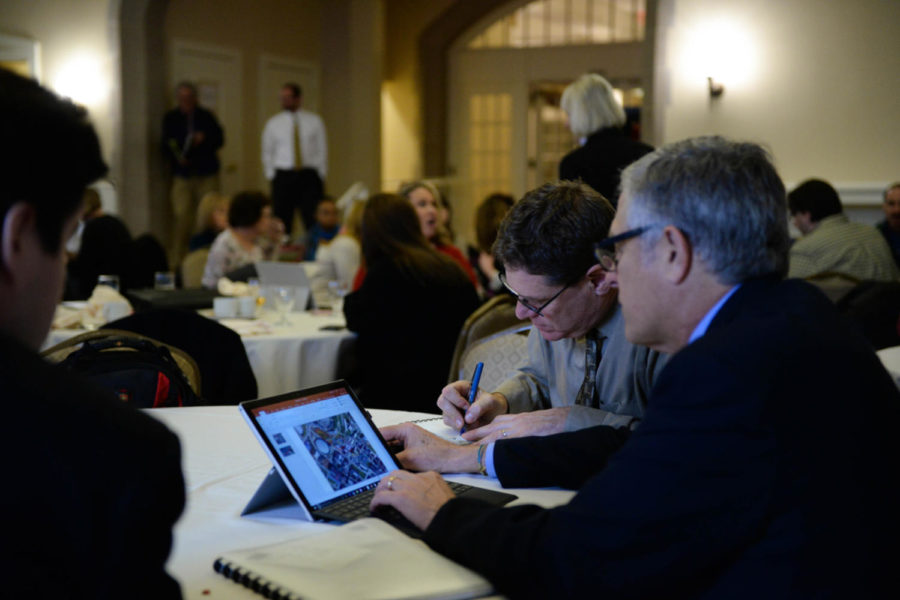Pitt’s unconventional hills, sidewalks and parks are what separate the University’s aesthetic from others, Ayers Saint Gross architecture and planning principal Kevin Petersen said.
“We want to address the quality, quantity and management of space,” Petersen said.
Ayers Saint Gross and Pitt’s Department of Planning and Design hosted three presentations regarding Pitt’s master plan for architectural development. The plan began during the summer of 2017 in the hopes of improving what campus will look like in the next 30 years.
Approximately 150 Pitt faculty, staff and community members attended the three meetings held at the University Club this week. Pitt faculty and staff attended the Wednesday afternoon and Thursday morning meetings, while Oakland residents attended a Wednesday evening meeting. Student Government Board will hold a similar presentation on the campus developments for students at their next meeting Tuesday, Jan. 30.
The first presentation allowed various Pitt faculty and staff to determine their perspective on the current phase of development goals. The second presentation attracted various non-Pitt community members — including Erika Strassburger, chief of staff for District 8 and a current candidate for its council seat. The third presentation followed the same structure as the first.
Although still in its infancy, the master plan is set to enhance Pitt’s urban setting with improved student housing, transportation, athletics and utility infrastructure, according to Petersen. Owen Cooks, assistant vice chancellor for planning and design, said the master plan can make aspects of Pitt’s campus more sustainable and accessible to students and faculty.
“It’s not just about new buildings, but also it’s about sustainability, accessibility and challenges around the topography,” Cooks said. “This has so far been a year-long endeavor, and it’s the first comprehensive plan in 50 years.”
During the late summer and early fall of 2017, Ayers Saint Gross and Pitt’s Department of Planning & Design held listening sessions and analytical discussions about specific ways to grow and change the campus. They also had conversations with potential stakeholders to address Pitt’s landscape.
“The topography here is seen as a barrier, talked about as a barrier, but we think it’s an asset,” Petersen said, “Space was the main focus, and people thought space was key to improving experiences on campus.”
Although there have been some positive responses to certain uses of campus space — including walkability, green space, laboratory research facilities and recreation facilities — the firm concluded from focus groups that there is still room for improvement. Complaints included the high-speed traffic of Forbes Avenue, accompanied by a lack of sidewalk space paralleling the road.
At the evening community meeting, Oakland residents wanted more neighborhood involvement for issues pertaining to student housing.
Norman Cleary, a North Oakland resident, expressed concerns regarding student housing that exists in neighborhoods that extend further from the campus.
“We are concerned about the resident compatibility that the University intends to incorporate into this plan,” he said in response to Petersen’s presentation. “More on-campus housing is desirable [for residents] because it reduces pressure of off-campus housing.”
Students are attracted to the affordability of existing off-campus housing, according to Eli Shorak, vice chancellor for business and real estate at Pitt. He said this is what drives the heavy student presence in the greater Oakland area and is important to keep in mind.
The resident community requested Pitt’s development team take a more inclusive approach that considers the residents’ opinions. Cooks said they will organize more community meetings to ensure residents are content.
Strassburger attended earlier community meetings regarding the master plan and intends to continue doing so. She considers Pitt’s transparency with the community to be the most adequate response to the housing concerns.
Cooks committed to continuing Pitt’s transparency for future development that could affect the Oakland community.
“Pitt can be a great equalizer, and we are sensitive that the University lives in a larger community,” he said. “We’ve tried and we will continue to try to be transparent because with transparency as a goal, we’ll derive the best input of what Pitt can do.”


